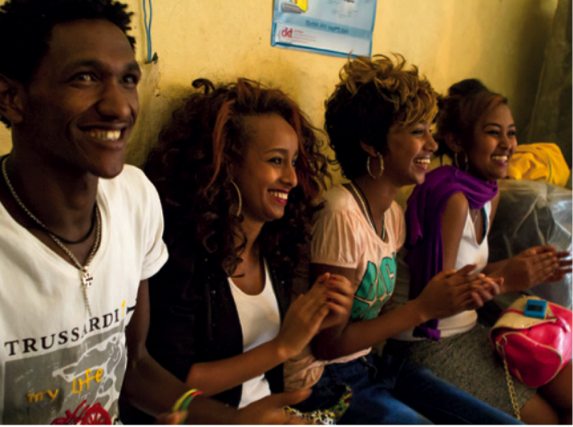The process of aligning channels and messages means selecting the right communication tool or approach for the message and the intended audience (for example, mass media, interpersonal communication, information and communication technology, or social media). Doing this well is a strategic process that is informed by program needs, the local context, and your audience analysis.
Why Is Selecting the Right Approach Important for Service Communication?
Aligning channels with messages helps ensure effectiveness by getting the best messages to the intended audience without wasting resources. Not all channels reach all audiences. Ensuring the right mix of channels increases repetition and improves the likelihood that the audience will understand the message, accept it, and act on it.
Key Steps for Aligning Channels with Messages
The result of aligning messages with communication channels is often called the Channel Mix Plan. The following are the key steps for developing the plan. Fill out the Channel Mix Table to develop your own plan.
- Assess the available channels – Determine what communication channels are locally available. To the right is a list of the typical channels and how they are often used in service communication.
- Determine the intended audience’s habits and channel preferences – Does the proposed channel reach the intended audience? For example, first determine whether the audience listens to the radio, watches television, or uses the social media before deciding to use one of those approaches. This information is gathered in the Audience Analysis section
- Consider the strengths and weaknesses of each channel – Channels may differ depending on the communication objectives and audience. Using a combination of several appropriate channels is likely to increase the effect of SBCC. To learn more about strengths and limitations of each channel, see Developing a Channel Mix Plan.
- Leverage the strengths of each tool – Not all channels are appropriate for all messages. Some messages and new behaviors require a lot of interaction, information, or time, particularly when introducing a new skill or addressing deeply held beliefs or misinformation. The message requirements will determine the appropriate format: interpersonal, small group, mass media, or social media. For example, teaching a new mother how to overcome challenges with breast attachment (latching) may be best addressed with interpersonal contact or through demonstration videos using mobile technology to show examples and to answer questions.
- Consider audience characteristics in creative decisions – Consider the intended audience’s literacy and education levels, time available, technical savvy, and other characteristics. Then, choose the most appropriate tools that also allow the necessary amount of creativity and innovation for the message.
- Determine what channels fit the program’s objectives, considering the stage of service delivery and make a list of those challenges – Is the program’s objective to inform and educate about a new service or product or to increase the intention to seek services? Is it to impart skills during a clinical encounter? Is it to reinforce new behaviors after the client leaves the facility? The objective should help you decide which channel is most appropriate.
- Determine whether the preference is for reach (number of individuals or households exposed to the messages) or intensity (average number of times individuals are exposed to the messages). The level of intensity may be determined by amount of depth (the necessary amount of information and detail) the message requires to be understood. Services that are intended for a narrower audience (uncircumcised youth or pregnant youth) intensity may be more appropriate. For new services or those targeting a large audience (for instance, family planning or malaria treatment in an malaria endemic area), the program may want to maximize reach over intensity.
- Is the tool appropriate for the setting where it will be used? Channel selection should consider where and when it will be used and the topic it addresses. For instance, clinical counseling may require materials suitable for a small and/or crowded clinical setting. Also be sure to consider infrastructure. Is electricity required for light or internet access?
- Consider the fit between messages and channels and the audience – Whether a message is somewhat complicated or requires visuals will determine whether print, video, radio or interpersonal communication is best. Consider local norms related to the health topic, including whether it’s difficult to discuss or is stigmatized, before making decisions about which communication channels to use.
- Determine frequency – how often will the channel be used? In doing so, consider aligning the channels with holidays, payment cycles, elections, or other special events. This will help you take advantage of opportunities and make sure that the messages are not obscured by other media stories.
- Summarize the results of this analysis into a Channel Mix Table (below). When making final channel selections, consider the budget – Is the channel affordable? Are there ways to collaborate with other partners or activities to minimize costs? Do production costs for this channel or approach fall within the budget? What is the cost per person reached, and is that reasonable? For instance, a radio spot may be more expensive to produce than community talks, but radio may reach many more people than the interpersonal communication sessions, reducing the cost per person reached.
Download Channel Mix Table
For step-by-step guidelines on aligning channels with messages and completing a Channel Mix Plan, see How To Guide - Developing A Channel Mix Plan.
For an example of how family planning messages were developed and disseminated through various channels to improve service delivery uptake, see the NURHI case study.
Message Channels
| Channel Types | Definition | Examples in Service Communication |
| Interpersonal:
Peer-to-peer, client/provider, supervisor to community health worker, counseling
|
The process by which two individuals (or a small group) exchange information and ideas through face-to-face interaction. |
|
|
Community Based: Community dialogue, community drama, community radio
|
A process that engages and motivates a wide range of partners and allies at national and local levels to raise awareness of and demand for a health topic or service |
|
|
Mass Media: Radio and television, serial dramas, game shows, websites, newspaper, magazines, posters
|
Diversified media technologies that are intended to reach large audiences via mass communication, including radio, film, and television. |
|
|
Social Media: Facebook, WhatsApp, SMS, blogs, podcasts
|
Internet-based services in which users generate online content, such as blogs, social network sites, and wikis. |
|

© 2016 International HIV/AIDS Alliance
Example
By aligning channels and messages with the right audiences, International HIV/AIDS Alliance was able to improve the sexual and reproductive health and rights (SRHR) of 940,000 10-24 year olds most affected by HIV across 5 countries. They recognized that changing attitudes and norms that influence young people’s access to services requires discussion, community interaction, provider behavior change, and advocacy. They used peer educators and youth leaders, along with hotlines and social media, to allow for in-depth discussion, open sharing, and youth advocacy. They used print materials to inform and refer youth to services. They took advantage of in-service training to sensitize and build provider capacity. Finally, the used interpersonal and community channels to advocate for integrated services and the creation of youth-friendly spaces.





